
|   |

|   |
Raindrops Festival - Chandra Anand e-mail: chandra6267@yahoo.co.in Photos courtesy: Samved July 29, 2018 Samved Society for Performing Arts is an institution dedicated to the promotion of Indian classical music and dance. Kathak exponent Uma Dogra founded Samved Society in 1990, after the untimely demise of her guru Pt. Durgalal. Through this institution, she attempts to keep his memory alive in hearts of generations to come. She keeps herself connected to her mentor by celebrating the Guru Shishya Parampara. The caption in the brochure "in my mentor's footsteps", below which she bows down at her guru's feet tells it all. Samved Society of Performing Arts pays homage to the master's eternal spirit through two main festivals - Pt. Durgalal Festival and Raindrops Festival. The first features renowned artists of the music and dance fraternity. The second held in Mumbai during the monsoon month of July encourages upcoming Indian classical dancers. In past 27 years, Raindrops Festival has welcomed over 200 artists, many of whom are leading exponents in their chosen fields today. These two festivals hold an iconic presence in the cultural calendar of Mumbai. Day one: July 14 Despite traffic and rains, it was delightful to find a houseful auditorium especially since it was a ticketed program. Each artiste was given a half hour slot. The first performance was by Vinod Kevin Bachan. Dressed in blue attire and with minimal jewelry he portrayed poise and grace suiting an Odissi dancer. He performed a Meera bhajan in which the beauty and romance of rainy season were described. He portrayed the pitter patter of the raindrops, the elegant dancing of peacocks which expressed joy and signified the feeling in Meera's heart. His next number Vishwaroop darshan described Lord Krishna's revelation of his Omnipresent Universal form to Arjuna, who inspired by the sermon of Bhagavad Gita, picks up his weapons and gets ready to fight. Compared to the previous item, this item was too short. Both items are choreographed by his guru Ranjana Gauhar. Vinod has been learning dance from a young age and he is also adept in Kuchipudi which he learnt first; his personal choice was to take up Odissi. Though confident and experienced, his abhinaya has scope for improvement.  Vinod Kevin Bachan 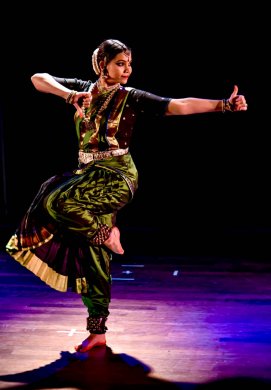 Sneha Chakradhar Sneha Chakradhar, disciple of Geeta Chandran, has a doctorate in the topic of "sociology of dance and performance making" with Bharatanatyam as her case study. Making a pleasant appearance in green costume with black border, she performed a thematic presentation of 'Shivadarshanam' commencing with Rudrashtakam, an octet by Tulsidas set to Ragamalika and Khanda nadai describing the fearsome manifestation of Lord Shiva. She moved on to a Ninda Stuthi in ragam Hamsadhwani in Hindi which is a perfect translation by her father Ashok Chakradhar, of the Tamil padam Edhai kandu nee ichai kondai in ragam Kalyani and adi talam. Here, the mother noticing Parvathi smitten by Shiva's appearance in a procession chides her and says that he is a mad man and not be the right person for her or for anyone to marry. She criticizes his appearance and many icons he adorns himself with. Still Parvathi decides to follow Shiva, leaving the mother to wonder, "What is it that my daughter sees in this man?" Sneha concluded her performance with a Thillana, a Lalgudi G. Jayaraman composition. She has excellent abhinaya and gave a performance befitting an experienced artist but she had a rather stern aura around her. In her presentation she described all of Shiva's attributes but adbhuta rasa that is normally the rasa that encompasses the audience through Shiva items was missing. Ameera Patankar had planned her presentation in a way that all items of Kathak repertoire were included. She started with a drupad set to japtaal, moving into thhaat, amaad, parans, paremelu, chakradhar all in japtaal. She performed a kavit in which ched chad was depicted. She also danced a bandish, "Morimuruki kalayi". Dressed in a dark green kurta chudidar and light mehndi green dupatta she spread a very sweet presence in the auditorium. A student of Guru Shama Bhate of Nadroop, Pune, she had the privilege of having her guru reciting the padant for her. The items were all rhythm bound. 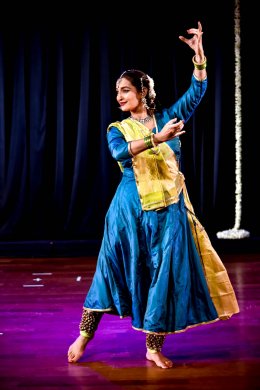 Ameera Patankar 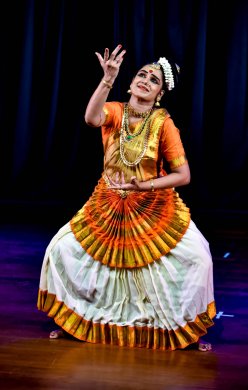 Sujatha Nair The last session of the first day was Mohiniattam by Sujatha Nair. She performed excerpts from Adi Sankara's Ardhanareeshwara sthotram, "Champeya gowrardha..." which extols the union or merging of dual principles of prakriti and purusha or Shakthi and Shiva into one form which represents the synthesis of masculine and feminine energies. They are in one form indicating duality and extremities of life. Albeit contradictions, they are one and at once the all pervading Supreme Power behind the universe. This was well depicted by Sujatha. Next she presented a Kshetrayya padam set to ragam Saurashtram, talam adi. In this Telugu composition, the nayika complains to her sakhi that she yearns to be united with her lord, but all her trysts with her lord are spoiled by a rooster which crows heralding the appearance of dawn. Sujatha concluded her recital with a lullaby in Malayalam "Omanathinkal kidavo" where the mother cajoles her little toddler to sleep. She compares her baby to the beautiful moon and lotus, his movements to the dancing peacock and voice to that of the cuckoo bird. And in her happiness she believes that Krishna himself is born to her to give her bliss and contentment. She brought the joy in her actions of walking with her son, in trying to feed and make him sleep. In the end she told her audience to not clap and disturb the sleeping child. All items were choreographed by her mother and guru Jayashree Nair. The bhakti element, the romantic element of a shy bride full of dreams and vatsalya elements were all brought out beautifully in her items. Day two: July 15 The evening's performances started with a Kuchipudi recital by Shweta Nayak. Her first item was ashtapadi "Chandana charchita" by Jayadeva. This ashtapadi is actually a one-to-one dialogue between Radha and her sakhi. The dancer describes pranks Krishna played on other gopis like how he pulled at the pallu of a gopi or stole butter from another gopi's house. "Shiva Shiva bhava bhava," a Narayanateertha tarangam, was set to Ragamalika and adi talam. She started with a shloka on Shiva. In this item, the dancer extolls Shiva as the Supreme God, and portrays his appearance as snakes adorning his neck, body smeared with ash, moon and Ganges on his hair locks and riding his vahana Nandi the bull. Her korvais in between all stanzas were clean and appropriate poses were taken at the end of each stanza. Also the story of Ganga getting arrested into hair locks of Shiva as punishment to stop her from destroying the earth was shown. Her adavus were neat and clean and the sound was clear as punctuated by the nattuvangam. The audience was enthralled to see the tarangam (dancing on the brass plate) which is the most awaited item in the Kuchipudi repertoire. Her steps on the brass plate matched the nattuvangam beats. She stole everyone's heart with a very energetic and enthusiastic presentation. Albeit this, in Shweta's first item one felt there was no synchronization between the music played and steps danced. And in a recorded music it is even more clearly noticeable if one is in step with music or not. It also was surprising to hear a sopanam music percussion instrument as part of Kuchipudi music ensemble. Overall, it was an enthusiastic, energetic and joy spreading presentation that was nritta oriented and descriptive. 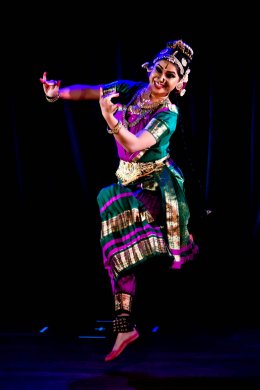 Shweta Nayak 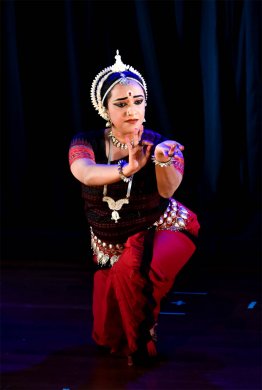 Sarbani Nandy Odissi was presented by Sarbani Nandy hailing from Tripura. In fact she is the first Odissi dancer of her state and conducts many workshops in interiors of north-east India. Her costume in red and black accentuated her poise. She started on a philosophical note through an item on panchabootas, an ode to the power and inevitability of the five elements (prithvi, jal, agni, vayu and akash) inhabiting all things existing in nature. She depicted how they supported and protected the existence of life. It was set to Ragamalika and Talamalika. In 'Nabadurga', a choreography of Guru Pankaj Charan Das, she brought out the persona of Goddess Durga very well. The Devi is depicted in all her nine forms and extolled as the mother and savior of all and ultimate source of life, peace and power. She protects her devotees and destroys evil in mankind. The introverted nature of Odissi form was sustained by her with minimalistic expression which conveyed everything. Clad in a multicolored costume, Bharatanatyam dancer Keertana Ravi began her recital with Jagan moha natana, a navarasa padam composed by Papanasam Sivan and choreographed by her late Guru Padmini Ramachandran. The piece reveals Shiva in all nine moods. Each rasa was delineated with appropriate story. All stories were kept short and sweet. At the end of each depiction of rasa, a pose was taken, but it was preceded by a slight frown, confusing the spectator to think there is more to tell or she forgot something. The ashtapadi, "Nindati chandana" in Darbari Kanada was dealt very well, choreographed by Keertana herself. Her abhinaya was intense and portrayed an involved presentation. Guru Paduka stotram written by Adi Shankaracharya, "Namo namaste sri guru padukabhyam" was choreographed by Keertana specially for Raindrops Festival. The music was composed by Manoj Desai and has rhythmic inputs by mridangam artist Kalishwaran Pillai. She dedicated this to both her gurus. She ended her presentation with a short two minute thillana. Though Keertana had good anga shuddam and involved abhinaya (except for the sudden frowns), there were only takitas and diditais used abundantly. It is the variety of cadences of movement that gives Bharatanatyam its stature. One also wondered at the choice of costume and subdued makeup. Manoj Desai, the versatile singer, sang for Keertana (Bharatanatyam) and Ameera (Kathak).  Keertana Ravi  Rohit Sonagra As the dais was getting ready for Rohit Sonagra, Uma Dogra gave tribute to Guru Padmini Ramachandran and her own Guru Pt Durgalal. She mentioned that when she had been to Bangalore to perform in a festival held by Padmini's institute Natya Priya, she had been told that Guruma could not come as she was bedridden. But as she was dancing, she saw Guruma coming into the auditorium - she said the sound of ghungroos and tabla had dragged her out of bed to see the performance. About Pt. Durgalal, she indicated the photo set up on the side which had her prostrating under the feet of Pt. Durgalal and said this is the bhav she had towards her guru. She said, in this photo she was fifteen years older than him, as he had died very young, but this is how she wishes to think of him. In those times, when she was learning from him, she was like Lakshman was to Sita (she was 31 and he was 42 when he died), she had only seen her guru's feet. Students then never looked into their guru's eyes while speaking to them and when he walked in front they walked a meter behind him soundlessly. She also said there are such students as well as gurus existing today too but how to develop and maintain such a pure relationship in the present scenario is the question now. The concluding performance was by Rohit Sonagra, who hails from a musically oriented family of the Jaipur Gharana. He was initiated into Kathak at the age of three by his father and guru Rajesh Kumar Sonagra who joined him on the dais with the music ensemble playing the harmonium and reciting the padant. His brother Prashant Sonagra accompanied on the tabla and Sandeep Mishra on the sarangi. When the performance started, Rohit Sonagra took elaborate namaskar and fell at the feet of Guru Durgalal and won everyone's heart as no other artiste had done that. He wore a mustard kurta and black pyjama and a black sash tied to his waist. With a tilak on his forehead he looked dressed up like Pt. Durgalal. But soon one realized it was to be a family presentation, all taking turns for solo time. Guru Rajesh Kumar Sonagra recited padant and also played a solo on the harmonium, Prashant played a little solo on the tabla and in between all this Rohit performed teen taal, Ganesh paran, Mayur paran. The family also showed their modesty by recalling other gurus and mentioned their specialties and performed those. In the last five minutes Sandeep Mishra also played a solo and in just two minutes showed his skill and won audience's heart. Rohit ended with thatkars. It was a very delightful presentation and gave a happy end to the two day event glorifying young artistes. Uma Dogra has tremendous faith that, in India, there are many rasikas who believe that watching Indian classical dance is an evening well spent; therefore it's a cause worth supporting. So with zeal and enthusiasm year after year with help from her students she organizes festivals, financing them herself without any external support. This festival is made possible by her determination, her passion, the goodwill she has earned over three and a half decades spent in the city. Chandra Anand is a Bharatanatyam artiste and teacher. She has an MA in Bharatanatyam from Tilak Maharashtra Vidyapeeth, and her series on 'Education in spiritual values through Bharatanatyam' is featured in narthaki.com. |